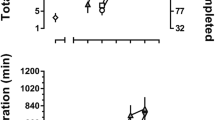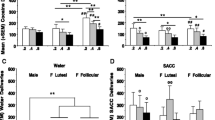Abstract
Rationale
There is disagreement in the literature with respect to how drugs of abuse affect the functioning of the hypothalamic–pituitary–adrenal (HPA) axis, and whether these changes in endocrine function may be related to the rewarding effects of these drugs.
Objectives
To determine whether reinforcing drugs with different mechanisms of action affect HPA axis function at doses at which they serve as reinforcers.
Methods
Seven monkeys (6 male) were randomly assigned to self-administer methohexital—a barbiturate (n=4), midazolam—a benzodiazepine (n=3), or ethanol (n=5). Each monkey had a surgically implanted indwelling venous catheter, and was trained to respond on a fixed ratio of 30 lever presses to receive an injection of drug or saline. Blood samples were obtained before, during, and after the self-administration sessions for the measurement of ACTH and cortisol by radioimmunoassay.
Results
Although methohexital, midazolam, and ethanol all maintained self-administration behavior across a range of doses, they differed in their effects on ACTH and cortisol. Ethanol inhibited ACTH and cortisol secretion. Methohexital and midazolam both tended to decrease ACTH and cortisol at large doses, and increase these hormones at small doses, but the HPA effects of neither drug differed significantly from when saline was available.
Conclusions
The neutral overall effect of methohexital and midazolam on HPA activity is consistent with other monkey and human studies, whereas the inhibitory effect of self-administered ethanol in the monkey contrasts with both the rat and human literature. The data in this study suggest that a change in HPA axis activity is not a requirement for drug-reinforced behavior in monkeys.



Similar content being viewed by others
References
Ator N, Griffiths R (1987) Self-administration of barbiturates and benzodiazepines: a review. Pharmacol Biochem Behav 27:391–398
Barrett A, Stockham M (1965) The response of the pituitary–adrenal system to a stressful stimulus: the effect of conditioning and pentobarbitone treatment. J Endocrinol 33:145–152
Beary M, Lacy J, Bhat A (1983) The neuroendocrine impact of 3-hydroxy-diazepam (temazepam) in women. Psychopharmacology 79:295–297
Borner U, Gips H, Boldt J, Hoge R, von Bormann B, Hempelmann G (1985) Effect of an introductory dose of etomidate, methohexital and midazolam on adrenal cortex function before and after ACTH stimulation. Deutsch Med Wochenschr 110:750–752
Broadbear JH, Winger G, Cicero T, Woods JH (1999) The effects of self administered cocaine on plasma ACTH and cortisol in male rhesus monkeys. J Pharmacol Exp Ther 289:1641–1647
Broadbear JH, Winger G, Rivier JE, Rice KC, Woods JH (2004a) Corticotropin-releasing-hormone antagonists, astressin B and antalarmin: differing profiles of activity in rhesus monkeys. Neuropsychopharmacology 29:1112–1121
Broadbear JH, Winger G, Woods JH (2004b) Self-administration of cocaine, fentanyl and ketamine: effects on the pituitary–adrenal axis in rhesus monkeys. Psychopharmacology (in press)
Buckingham J (1984) Inhibition of corticotrophin releasing factor secretion in the pentobarbitone–morphine-treated rat. Eur J Pharmacol 98:211–221
Cami J, de la Torre R, Garcia-Sevilla L, Ugena B, Knobel H, Segura J (1988) Alcohol antagonism of hypercortisolism induced by naloxone. Clin Pharmacol Ther 43:599–604
Carney J, Landrum R, Cheng M, Seale T (1991) Establishment of chronic intravenous drug self-administration in the C57BL/6J mouse. Neuroreport 2:477–480
Charney D, Breier A, Jatlow P, Heninger G (1986) Behavioral, biochemical, and blood pressure responses to alprazolam in healthy subjects: interactions with yohimbine. Psychopharmacology 88:133–140
Cudd T, Chen W, West J (1996) Acute hemodynamic, pituitary, and adrenocortical responses to alcohol in adult female sheep. Alcohol Clin Exp Res 20:1675–1681
Davies M (2003) The role of GABAA receptors in mediating the effects of alcohol in the central nervous system. J Psychiatr Neurosci 28:263–274
Davis J, Jeffcoate W (1983) Lack of effect of ethanol on plasma cortisol in man. Clin Endocrinol 19:461–466
D’Haese J, Camu F (1993) Influence of propofol and methohexitone anesthesia on the cortisol response to surgery. Acta Anaesth Belg 44:135–139
Galici R, Pechnick RN, Poland RE, France CP (2000) Comparison of noncontingent versus contingent cocaine administration on plasma corticosterone levels in rats. Eur J Pharmacol 387:59–62
Greer M, Rockie C (1968) Inhibition by pentobarbital of ether-induced ACTH secretion in the rat. Endocrinology 83:1247–1252
Griffiths R, Bigelow G, Liebson I (1979) Human drug self-administration: double-blind comparison of pentobarbital, diazepam, chlorpromazine and placebo. J Pharmacol Exp Ther 210:301–310
Griffiths R, Lukas S, Bradford L, Brady J, Snell J (1981) Self-injection of barbiturates and benzodiazepines in baboons. Psychopharmacology 75:101–109
Griffiths R, Lamb R, Sannerud C, Ator N, Brady J (1991) Self-injection of barbiturates, benzodiazepines and other sedative-anxiolytics in baboons. Psychopharmacology 103:154–161
Ida Y, Tsujimaru S, Nakamaura K, Shirao I, Mukasa H, Egami H, Nakazawa Y (1992) Effects of acute and repeated alcohol ingestion on hypothalamic-pituitary–gonadal and hypothalamic–pituitary–adrenal functioning in normal males. Drug Alcohol Depend 31:57–64
Insel T, Ninan P, Aloi J, Jimerson D, Skolnick P, Paul S (1984) A benzodiazepine receptor-mediated model of anxiety. Studies in nonhuman primates and clinical implications. Arch Gen Psychiatry 41:741–750
Kalman B, Kim P, Cole M, Chi M, Spencer R (1997) Diazepam attenuation of restraint stress-induced corticosterone levels is enhanced by prior exposure to repeated restraint. Psychoneuroendocrinology 22:349–360
Kalogeras K, Calogero A, Kuribayiashi T, Khan I, Gallucci W, Kling M, Chrousos G, Gold P (1990) In vitro and in vivo effects of the triazolobenzodiazepine alprazolam on hypothalamic–pituitary–adrenal function: pharmacological and clinical implications. J Clin Endocrinol Metab 70:1462–1471
Korbonits M, Trainer P, Edwards R, Besser G, Grossman A (1995) Benzodiazepines attenuate the pituitary–adrenal responses to corticotropin-releasing hormone in healthy volunteers, but not in patients with Cushing’s syndrome. Clin Endocrinol 43:29–35
Lukas S, Mendelson J (1988) Electroencephalographic activity and plasma ACTH during ethanol-induced euphoria. Biol Psychiatry 23:141–148
Makara G, Stark E (1974) Effect of gamma-amino butyric acid (GABA) and GABA antagonist drugs on ACTH release. Neuroendocrinology 16:178–186
McCaul ME, Wand GS, Stauffer R, Lee SM, Rohde CA (2001) Naltrexone dampens ethanol-induced cardiovascular and hypothalamic–pituitary–adrenal axis activation. Neuropsychopharmacology 25:537–547
Mehta AK, Ticku MK (1999) An update on GABAA receptors. Brain Res Rev 29:196–217
Mendelson JH, Mello NK, Sholar MB, Siegel AJ, Mutschler N, Halpern J (2002) Temporal concordance of cocaine effects on mood states and neuroendocrine hormones. Psychoneuroendocrinology 27:71–82
Pericic D, Lakic N, Manev H (1984) Effect of diazepam on plasma corticosterone levels. Psychopharmacology 83:79–81
Plotsky P, Otto S, Sutton S (1987) Neurotransmitter modulation of corticotropin-releasing factor secretion into the hypophysial portal circulation. Life Sci 41:1311–1317
Rivier C, Bruhn T, Vale W (1984) Effect of ethanol on the hypothalamic–pituitary–adrenal axis in the rat: role of corticotropin-releasing factor (CRF). J Pharmacol Exp Ther 229:127–131
Rohrer T, Von Richthofen V, Schulz C, Beyer J, Lehnert H (1994) The stress-, but not corticotropin-releasing hormone-induced activation of the pituitary–adrenal axis in man is blocked by alprazolam. Horm Metab Res 26:200–206
Schuckit M, Gold E, Risch C (1987) Plasma cortisol levels following ethanol in sons of alcoholics and controls. Arch Gen Psychiatry 44:942–945
Schuckit M, Risch S, Gold E (1988) Alcohol consumption, ACTH level, and family history of alcoholism. Am J Psychiatry 145:1391–1395
Stott D, Ball S, Inglis G, Davies D, Fraser R, Murray G, McInnes G (1987) Effects of a single moderate dose of alcohol on blood pressure, heart rate and associated metabolic and endocrine changes. Clin Sci 73:411–416
Takada K, Winger G, Cook J, Larscheid P, Woods J (1986) Discriminative and adversive properties of β-carboline-3-carboxylic acid ethyl ester, a benzodiazepine receptor inverse agonist, in rhesus monkeys. Life Sci 38:1049–1056
Tallarida RJ, Murray RB (1987) Manual or pharmacologic calculations with computer programs. Springer, Berlin Heidelberg New York
Vanover K, Wenger G, Woolverton W (1989) Self-administration of the isomers of pentobarbital and secobarbital by rhesus monkeys. Pharmacol Biochem Behav 34:669–671
VanVugt D, Washburn D, Farley A, Reid R (1997) Hypoglycemia-induced inhibition of LH stimulation of ACTH secretion in the rhesus monkey is blocked by alprazolam. Neuroendocrinology 65:344–352
Williams KL, Winger G, Pakarinen ED, Woods JH (1998) Naltrexone reduces ethanol- and sucrose-reinforced responding in rhesus monkeys. Psychopharmacology 139:53–61
Williams KL, Broadbear JH, Woods JH (2004) Non-contingent and response-contingent intravenous ethanol attenuates the effect of naltrexone on hypothalamic–pituitary–adrenal activity in rhesus monkeys. Alcohol Clin Exp Res 28:566–571
Winger G, Stitzer M, Woods J (1975) Barbiturate-reinforced responding in rhesus monkeys: comparisons of drugs with different durations of action. J Pharmacol Exp Ther 195:505–514
Yanagita T, Takahashi S (1973) Dependence liability of several sedative-hypnotic agents evaluated in monkeys. J Pharmacol Exp Ther 185:307–316
Acknowledgements
The authors wish to thank Nicholas Jones, Deborah Huntzinger, Sarah Pilkington and Laurie McDowell for their expert technical assistance. Animals used in these studies were maintained in accordance with the “Principles of laboratory animal care” (http://www.nap.edu/readingroom/books/labrats/), and all studies reported here were carried out in consultation with the University of Michigan Committee on Animal Care and Guidelines of the Committee on the Care and Use of Laboratory Animal Resources, National Health Council (Department of Health, Education and Welfare, ISBN 0-309-05377-3, revised 1996). This work was supported by the United States Public Health Service Grants DA 0916, DA 00254, and AA13783.
Author information
Authors and Affiliations
Corresponding author
Rights and permissions
About this article
Cite this article
Broadbear, J.H., Winger, G. & Woods, J.H. Self-administration of methohexital, midazolam and ethanol: effects on the pituitary–adrenal axis in rhesus monkeys. Psychopharmacology 178, 83–91 (2005). https://doi.org/10.1007/s00213-004-1986-4
Received:
Accepted:
Published:
Issue Date:
DOI: https://doi.org/10.1007/s00213-004-1986-4




